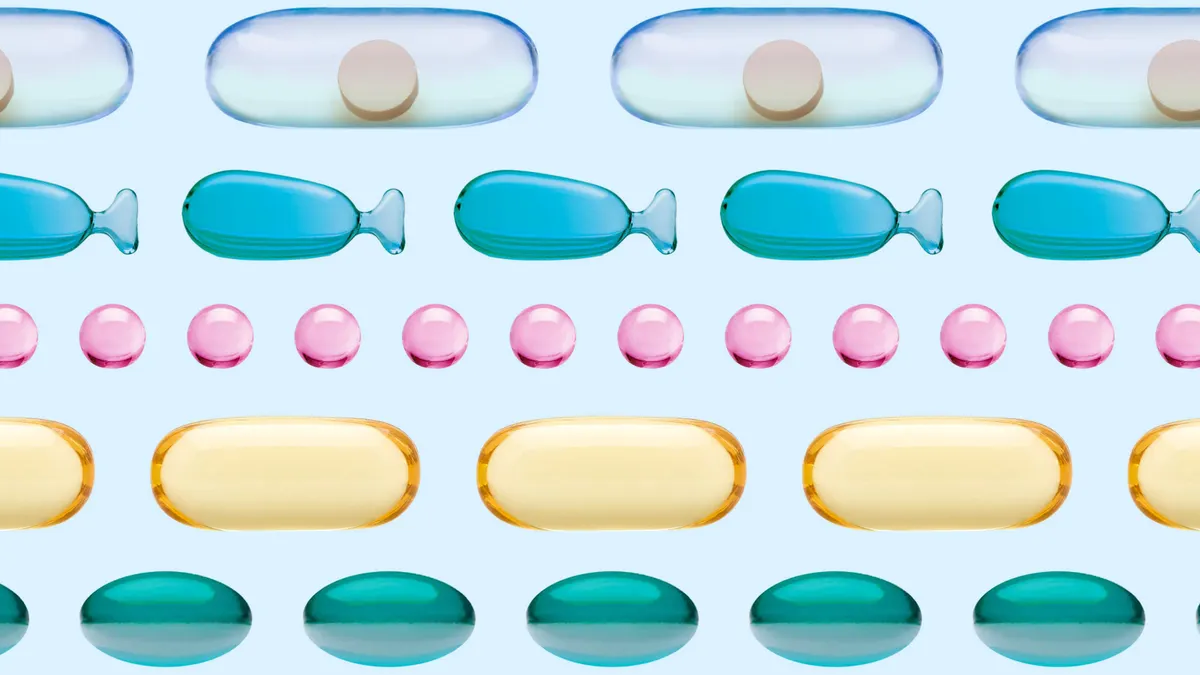As launches get increasingly competitive, with the potential for multiple therapeutics to target the same indications, therapeutics developers must take advantage of every opportunity to maximize efficacy and stand out in the market.
Against this backdrop, biopharma brands must explore every potential option to balance efficacy, shelf-stability, cost, as well as the patient and provider experiences to find the optimal formulation. In this article, we’ll explore the potential benefits of lipid-based softgel formulations — and how softgels have helped sponsors across the industry to improve the efficacy and stability of their therapeutics.
Lipid-based softgel formulations: A primer
Softgels themselves aren’t a new innovation — Catalent’s RP Scherer softgel technology, for example, has been in use for many decades.1 However, innovative softgel technologies offer a range of benefits that make them an attractive option for therapeutics developers today.
Traditional gelatin shells have been a mainstay in the industry; however, the emergence of plant-based options provides an attractive alternative that caters to diverse patient needs and preferences.
Lipid-based formulations in softgels can help reduce chemical degradation of sensitive Active Pharmaceutical Ingredients (APIs). Adjusting aspects such as capsule shell composition (including opacifiers or plasticizer systems) or fill composition (using lipid suspensions or antioxidants) may enhance protection of APIs from photodegradation, hydrolysis, or oxidation.
“At Catalent, we are equipped to tackle the challenges associated with APIs, including poor solubility, permeability issues, stability, and scalability,” says Benoit Hilbold, scientific development lead at Catalent. “Our expertise extends to processing complex formulations, including liquid and highly potent APIs, ensuring uniformity and safety in each dose.”
They’re particularly useful for enhancing the bioavailability of therapeutics with poor aqueous solubility. Softgels also dissolve rapidly, offering a faster onset of action that allows sponsors to lower their API dosage, while potentially enhancing performance.
Leveraging softgels to enhance performance
Optimizing performance was certainly top of mind for one of Catalent’s clients when selecting a formulation. They were developing a potent and highly selective inhibitor of Bruton Tyrosine Kinase (BTK) to treat hematologic malignancies with central nervous system (CNS) involvement.
“This was a challenging case: The therapeutic had low aqueous solubility, limiting its bioavailability. And on top of that, it was highly sensitive to light and oxidation,” says Amruta Mhashilkar, associate director of product development at Catalent.
The company had explored a spray-dried dispersion formulation, but found a large coefficient of variation (CV) that made the formulation unsuitable.
Catalent stepped in and suggested a self-emulsifying lipid-based formulation, that both improved bioavailability and decreased CV from 21.6% (in SDD) to 7.5% (in LBF) in the preclinical PK study.2
“Thanks to these improvements, we were able to reduce the estimated maximum clinical dose to 10 times lower than the dose used in the GLP toxicology study,” says Mhashilkar. “And, because the softgel formulation decreased exposure to light and oxidation, we were able to enhance stability as well.”
Building more stable shell formulations
In addition to potentially shielding therapeutics from light and oxidation, the optimal shell design can help pharma brands maximize the shelf-stability of their therapeutics.
Suboptimal softgel formulations can carry the risk of cross-linking, which affects dissolution and release rates of APIs, especially during early-stage development.
Gelatin cross-linking can significantly alter softgel behavior in both in-vitro and in-vivo conditions by extending dissolution time and API release. This process results from gelatin polymerization, triggered by factors such as temperature, humidity, light exposure, dyes, or aldehydes from the formulation or packaging.3 Careful selection of fill and shell ingredients can help reduce cross-linking issues.
“Based on the trending analysis of stability data for soft gelatin capsules, it seems that we can avoid cross-linking issues by carefully choosing the right fill and shell composition,” says Hilbold. “Additionally, selecting specific grades of excipients can help prevent this problem even further. By taking this approach, we can effectively mitigate cross-linking without wasting unnecessary time and resources on optimization during the early phases of formulation.”
Given the importance of stability, Catalent’s scientists set out to find more shelf-stable formulations that would resist cross-linking. To that end, they assessed five types of gelatin with varied plasticizer compositions to identify the best fit for reducing cross-linking under accelerated storage conditions.4
“We found we could improve stability with the right combination of antioxidants and plasticizers. Combined with optimizations to the gelatin content of the capsule, the resulting softgels would resist cross-linking even after six months of storage at 40°C and 75% relative humidity,” says Hilbold.
The bottom line
Finding the right formulation is mission-critical for effective therapeutics — and Catalent’s clients are leveraging softgel technology to optimize performance and shelf-stability, even for difficult therapeutics.
References:
1. Gullapalli RP. Soft gelatin capsules (softgels). J Pharm Sci. 2010 Oct;99(10):4107-48.
2. Case Study. Enhancing Drug Performance Through Lipid-Based Formulations for CNS Indication. Catalent. 2025.
3. Damian, F.,et. al, (2021). Challenges of Dissolution Methods Development for Soft Gelatin Capsules. Pharmaceutics, 13(2), 214.
4. Case Study. Optimizing Softgel Shell Formulation to Minimize Cross-Linking. Catalent. 2025.






